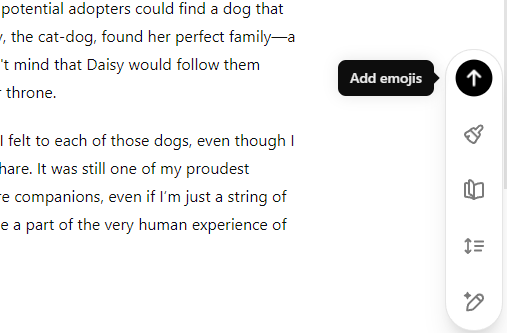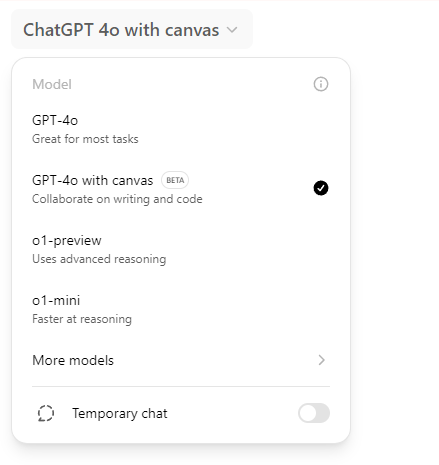In an era where AI is reshaping every aspect of our work, OpenAI has just raised the bar with ChatGPT Canvas. This groundbreaking feature isn't just another update—it's a paradigm shift in how we interact with AI for writing and coding. With 89% of companies already using or considering AI tools (Forbes, 2023), Canvas arrives at a crucial moment.
In this blog, we'll explore the most compelling aspects of Canvas and explain why it's not just an add-on tool but a fundamentally new way to collaborate and why it matters for professionals across industries. We'll also examine alternatives that might fit your workflow if you're exploring other options.
What is ChatGPT Canvas?
The ChatGPT Canvas is an innovative interface designed to enhance collaboration in writing and coding projects. Unlike the traditional chatbot interface, Canvas opens in a separate, dedicated window, providing a more direct and structured workspace for your content—whether it's long-form writing, coding, or other creative outputs.

Imagine having a virtual assistant that works alongside you, similar to using Google Docs or Notion. This workspace allows for seamless editing, commenting, and co-authoring with GPT-4, making it ideal for content creators, developers, and researchers. Picture drafting an article or developing a code script while having ChatGPT offer inline feedback and make instant modifications—all with just a click.
Key Features of ChatGPT Canvas

1. Inline Feedback and Suggestions

One of Canvas's standout features is its ability to provide inline comments and suggestions. Users can highlight specific sections of text and receive immediate feedback. Whether you're drafting a scholarly article or a creative blog, ChatGPT can suggest edits, enhance stylistic elements, refine coherence, or adjust the reading level—all in a straightforward interface. For developers, this means adding comments to your code or receiving suggestions to improve readability. Canvas turns coding into an interactive, iterative process, enabling bug fixes and adding explanations directly within the text.
For developers, this means adding comments to your code or receiving suggestions to improve readability. Canvas turns coding into an interactive, iterative process, enabling bug fixes and adding explanations directly within the text.
2. Advanced Editing Capabilities

Canvas offers a highly intuitive editing experience. You can select any text, add headings, apply bold or italics, and use commands to adjust formatting. This grants you the freedom to refine content without cumbersome back-and-forth prompts—everything stays in one accessible workspace. You can also transform highlighted text into different structural elements like headers or bullet points. This functionality combines the flexibility of Notion with the simplicity of Google Docs, making it particularly useful for writers and editors aiming for meticulous refinements.
3. Reading Level and Content Length Adjustments


On the right hand bottom corner you will see edit button with that, Canvas allows for seamless adjustments to the reading level of your content. Whether you need to produce a technical paper or a story for young readers, Canvas can modify the text to suit different audiences—from a middle-school level to advanced academic tones. You can also adjust the content length by condensing it for brevity or expanding it for more depth, offering nuanced control over your writing. This adaptability is especially useful for tailoring content to specific audiences and making complex material more accessible.
4. Polish content and add emojis


Add Polish contents will check for the grammar, clarity of contents and apply mechanism to make the whole content consistent. This is a good added feature to give your content a edge.
Next Feature is add emojis, this makes the content rich with emojis. I am not a big fan of this for now, as it makes the content very rich with emojis which is not useful anywhere professionally as per my opinion unless you are in dead love with emojis 😉.
I hope, and at same time I request ChatGPT team that in next update we will get a option to manage the content depth of emojis in draft.
5. Comprehensive Code Collaboration Tools

Canvas excels in software development. Users can paste their code and access powerful tools such as:
- Code Review: ChatGPT analyzes your code and suggests improvements, promoting better coding practices.
- Add Logs or Comments: Inserts print statements to clarify your code's functionality. Adding logs makes debugging simpler by placing print statements at critical points.
- Fix Bugs and Port Code to Different Languages: The bug-fixing feature scans and corrects errors in your code. Additionally, Canvas allows for easy code conversion across programming languages like JavaScript, TypeScript, Python, Java, C++, or PHP.
How to Activate Canvas
To start using the Canvas feature, select GPT-4 with Canvas from the model selector in ChatGPT. This opens a separate collaborative window for intuitive editing, coding, and real-time interaction with your content.

ChatGPT Canvas vs. Alternative Tools
While Canvas is a significant step forward in enhancing ChatGPT's collaborative capabilities, there are several alternatives that offer distinct features:
AI-Powered Writing Assistance
ChatGPT Canvas | ChatGPT Canvas offers inline feedback, suggestions for improvement, and the ability to adjust text length and reading level, which makes it stand out in competition. |
Claude 3.5 Sonnet | Claude 3.5 Sonnet provides advanced language understanding and generation with the dedicated writing interface, Artifacts similar to Canvas, but lacks with detailed features like ChatGPT Canvas. |
Cursor AI | Cursor AI focuses on code generation and completion, with less emphasis on general writing tasks. |
Perplexity AI | Perplexity AI specializes in information retrieval and summarization rather than collaborative writing. |
Code Support
Feature | ChatGPT Canvas | Notion | Claude 3.5 | Cursor AI | Perplexity AI |
Code review | Yes | No | Limited | Yes | No |
Add comments | Yes | No | No | Yes | No |
Bug fixing | Yes | No | Limited | Yes | No |
Language porting | Yes | No | Limited | Yes | No |
ChatGPT Canvas excels in coding support, offering features like code review, automatic comment generation, and language porting. Cursor AI is its closest competitor in this aspect, while the others have limited or no coding-specific features.
Which feature do you find most useful in ChatGPT Canvas?
To participate in poll click on the link and share your feedback.
Why Canvas Matters: Pioneering AI Collaboration
Canvas marks a pivotal evolution in the way users interact with AI. Instead of ChatGPT being just a passive assistant, Canvas turns it into an interactive collaborator. This partnership fosters not only content generation but also genuine co-development, allowing users and AI to iterate together—much like having a co-author or technical assistant at your side. Whether you're a software developer needing organized and understandable code, a writer refining your prose, or an academic seeking simplified explanations for complex topics, Canvas presents a compelling new way to achieve your goals.
Have you ever wished for a writing assistant that could understand context as well as a human editor? Canvas might just be the answer you've been looking for.
Related Reads
To deepen your understanding of AI in project management and digital transformation, explore these related articles:
How to Effectively Use ChatGPT in Project Management - Discover practical ways to integrate ChatGPT into your project management workflow for enhanced productivity.
The Digital Transformation of Project Management: Tools and Trends Shaping TomorrowThe Digital Transformation of Project Management: Tools and Trends Shaping TomorrowThe Digital Transformation of Project Management: Tools and Trends Shaping TomorrowThe Digital Transformation of Project Management: Tools and Trends Shaping Tomorrow - Explore how digital tools like ChatGPT Canvas fit into the broader landscape of project management transformation.
Navigating the Digital Shift: Effective Change Management Strategies for Success - Learn how to manage the organizational changes that come with adopting AI tools like ChatGPT Canvas.
The Agile Mindset in Non-Tech Environments - Understand how tools like Canvas can support agile methodologies in various business contexts.
These articles will provide you with a comprehensive understanding of how AI tools like ChatGPT Canvas fit into the broader context of modern project management and digital transformation.
Conclusion: Start Your Collaborative Journey with Canvas
With the introduction of Canvas, ChatGPT has evolved into a sophisticated collaborative workspace that supports content creation, editing, debugging, and more. If you're looking to boost your productivity in writing or coding, exploring this feature is highly recommended.
Ready to experience the future of collaborative work? Start your journey with ChatGPT Canvas today and join the ranks of professionals leveraging AI to boost their productivity and creativity. Share your Canvas experience in the comments below or reach out to discuss how AI is transforming your workflow!
How do you see AI changing the future of collaborative work? Are you ready to embrace it? Let's continue the conversation about how AI is reshaping the future of content creation and collaboration.

Questions? Collaborations? Let's talk!
Interested in collaborative ventures, innovative projects, or have a query? I'm just a message away